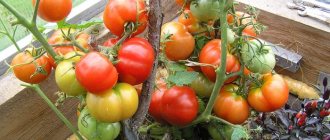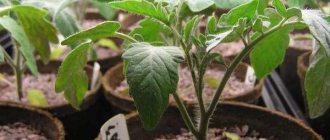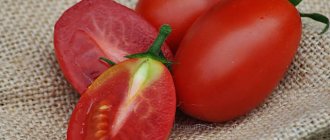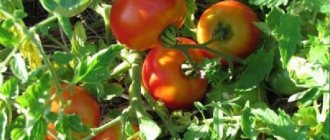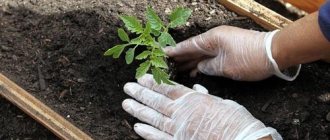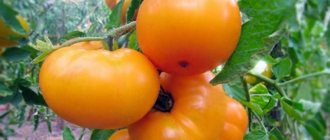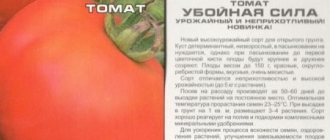Morning dew is considered one of the best early ripening tomatoes. Gardeners who grow this variety distinguish it from other early ripening varieties for the beauty and taste of the fruit.
| Height | Landing location | Ripening time | Fruit color | Fruit size | Origin | Fruit shape |
| Tall | Open ground | Early ripening | Reds | Large | Variety | Heart-shaped |
Description and characteristics of the variety
The Morning Dew tomato was bred at once by two agricultural enterprises (Moscow) and the Pridnestrovian Research Institute of Agriculture (Tiraspol). The cultivar is recommended for cultivation in all regions and was included in the register in 1999.
Tomatoes can be planted in open ground and under unheated film. It is of interest to small farms, owners of gardening and household plots.
The variety is early ripening, ripens 3.5 months after the appearance of true leaves. The fruits are shaped like a heart, with faint ribs running close to the stalk. When ripe, tomatoes are bright red, without any hint of pink or raspberry color. There are 4 or more seed chambers, few seeds. The average weight of the fruit is more than 200 g. The taste is excellent.
The plants are tall, the stem height is up to 2 m. In open ground, the bush will grow up to 160 cm, so even at the stage of choosing a variety you need to think about the option of securing and gartering. The leaves are colored gray-green, the plates are medium in size.
How to grow
Let's take a closer look at the features and nuances of growing Morning Dew tomatoes.
Planting seeds
When purchasing planting material, pay attention to its freshness, since seed germination directly depends on this. Sowing time is the end of March.
Sow seeds in containers according to package instructions. Choose nutritious soil, preferably special soil for tomatoes. The depth of planting the seeds is 1.5 cm. After this, sprinkle the seeds on top with dry sifted soil, moisten them with water at room temperature from a spray bottle and cover with a plastic bag.
As the soil dries, the bag should be removed and the soil moistened. Make sure that the soil in the containers does not dry out. This is especially important at first.
Important ! Do not put containers in a dark place, as this will increase the germination time of the seeds.
Shoots
Already on the tenth day, the first shoots appear. We immediately remove the bags and place the containers in a well-lit place. When the first two leaves of the tomatoes appear, we transplant each seedling into a separate glass or peat pot.
Before transplanting the sprouts into the soil, we add mineral fertilizers to the soil several times (according to the instructions on the package). If you plan to plant tomatoes in open ground and not in a greenhouse, we recommend that you begin to “harden off” the seedlings approximately 1 or 2 weeks before planting, that is, take them outside for a short time.
At the age of one and a half months, we plant the seedlings in open ground or in a greenhouse. The recommended planting density is no more than three to four plants per 1 square meter. m. This will ensure a higher yield.
Important ! You can start planting tomatoes in a greenhouse as early as the second ten days of April, but if you plan to plant them in open ground under film, no earlier than mid-May. This applies to central Russia.
Growing and care
Caring for tomatoes of this variety consists of timely watering, loosening the soil and regularly pinching the top of the plant stem. Tie the bushes to supports in a timely manner so that branches and brushes do not break under the weight of the fruit. Pinching the stem is especially important for greenhouses, where low growth of bushes is most important.
To increase the yield of tomatoes, it is recommended to stepchildren, that is, remove useless side branches. As a result of this, you will get the correct formation of the plant. Only fruiting branches will remain on the bush.
Water the tomatoes sparingly, at the root, as the soil dries. Tomatoes do not tolerate stagnation of water in the hole. It is best to do this in the evening or early in the morning. Remove weeds and loosen the soil. Perform all spraying against diseases or pests in dry, cloudy, windless weather, preferably early in the morning or in the evening after sunset.
Diseases and pests
The Morning Dew variety is resistant to various diseases: tobacco mosaic, brown and bacterial spot.
To prevent late blight, regularly ventilate greenhouses and do not over-moisten the soil, since late blight is a fungal disease. Mushrooms are known to grow where it is damp. It is also recommended to spray the bushes with whey once a week or use the preparations “Fitosporin”, “Barrier” or “Barrier”.
The main pests of tomatoes are spider mites, whiteflies, cutworms, wireworms, root-knot nematodes and mole crickets. You need to fight them at the first sign of their appearance.
Spider mites are small arachnids that feed on the sap of leaves and entangle them in a thin web. Dots first appear on the sheet, after which the sheet dries and falls off. Most often, the mite attacks tomatoes with poor watering and rare ventilation of greenhouses. Prevention measures: water the tomatoes in a timely manner and ventilate the greenhouse. Control measures: spray the bushes and soil with Fitoverm (1 ml per 1 liter of water), treat the tomatoes with an infusion of garlic or onion peels (200 g of husk per 1 liter of water).
Whitefly harms tomatoes at the larval stage. Pale green oval larvae feed on the sap of the leaves, and with them a sooty fungus appears on the plant. The leaves dry out and die. Prevention methods: Inspect plants regularly and if larvae are found, immediately remove affected leaves. Control methods: spraying with “Phosbecid” (10 ml per 10 liters of water) or “Cytcor” (1.5 ml per 10 liters of water). If necessary, repeat treatment after 15-20 days.
Gnawing armyworm - caterpillars 3-4 cm long, black, brown or gray. They eat stems and leaves at night. Prevention methods: Remove weeds regularly and dig the soil deeply. Control methods: manually collect caterpillars, spray the plants with the Strela biological product (50 g of powder per 10 liters of water).
Wireworms are yellow caterpillars, the larvae of click beetles, that eat the roots and stems of tomatoes. Prevention methods : Regularly dig up the soil, manually collecting caterpillars. Before planting tomatoes in the greenhouse, place 15-20 cm long sticks in the soil with raw potatoes, carrots or beets strung on them, root side down. After 2-3 days, pull these traps out of the ground along with the root crops and burn them.
Control methods: in case of mass accumulation of caterpillars, mix the drug “Bazudin” with sand or sawdust, bury it in the soil next to the tomatoes.
Root-knot nematodes are small worms that penetrate the soil along with planting material. They feed on plant roots, forming growths and swellings on them. Affected tomatoes grow poorly and bear little fruit. Prevention methods: before planting seedlings, remove the top layer of soil and dig up the remaining part, add 1 Glyocladin tablet to each planting hole.
Control methods: water the plants with Ecogel solution every 2 weeks; in case of severe nematode infestation, treat the soil with Basamil.
The mole cricket is a fairly large pest, reaching a length of 10 cm. It affects the root system of tomatoes, arranging its nests in the soil. The mole cricket lays up to 300 eggs in one nest, from which the larvae then crawl out and begin to eat the roots of the plants. Prevention methods: do not over-moisten the soil; mole crickets most often make their nests where there is an excess of moisture.
Control methods: when an insect is found, pour 2 cups of table vinegar or 0.5 liters of hot pepper infusion (150 g of chopped pepper per 10 liters of water) into each hole; use granular preparations, such as “Medvetox”, “Granula”, “Rembek”, “Thunder”, “Force” or “Grizzly” (bury the granules in the soil to a depth of 10-15 cm).
Description of morning dew tomatoes, with photos.
Recommendations for growing:
The bushes of this plant are indeterminate, which means that you will have to shape them yourself, trim and pinch them, especially if you grow tomatoes in greenhouses. Since the fruits are quite impressive, the bushes will need to be tied to a trellis, otherwise they will break under the weight of the tomato. According to reviews from summer residents who grew morning dew tomatoes, it becomes clear that you need to form the bush into one stem, this way you will get better results in terms of yield.
Planting density is approximately three plants per square meter. The yield of one bush will be approximately 3 kilograms, a tomato of excellent quality.
No special care is required for this variety; it will only be enough to limit yourself to the standard set: weeding, regular watering, loosening the soil, and applying mineral fertilizers.
Tomato fruits morning dew photo:
Tomatoes of this variety are large, fleshy, about 250 grams, glossy skin, bright red. The surface is ribbed, the fruits are heart-shaped. The fruits have good shelf life and transportability, for which they are valued among summer residents and farmers who grow tomatoes for sale. The taste of the fruits is high; it is best to eat them fresh; due to their size, the fruits are not very suitable for preservation.
Advantages of the morning dew tomato variety:
The main advantages, according to reviews from those who planted morning dew tomatoes, are the following points:
- Great-tasting fruits;
- High commercial quality;
- Resistance to most diseases and pests of tomatoes;
- Easy to grow;
- Resistant to cold weather, and also performs well in dry and hot climates;
- The fruits do not crack;
- Friendly fruiting.
Feedback from our readers:
Olga writes : “As an intermediate result, I can say that the tomato is very hardworking and knits very well.”
And here is the actual photo result:
From all of the above, and from the reviews of gardeners, we can conclude that the morning dew tomato is simply ideal for those who love fleshy, large and tasty tomatoes. In addition, they are not very demanding in care, resistant to disease, do not crack and have good shelf life and transportability. We strongly recommend that every summer resident try to grow morning dew tomatoes on their own plot, you will not regret it. With this we say goodbye to you, we wish you all the best, see you again on our farm website!
Reviews
According to farmers' reviews, tomatoes of this variety have excellent yields, are easy to care for and resistant to diseases. Gardeners especially highlight their wonderful rich taste and meatiness. Although there are negative reviews, they are few.
Here are some of the reviews:
Valentina: “The Morning Dew variety (improved Red Bull's Heart) always pleases with a large harvest - up to 6 kg per plant. The fruits are bright red, dense, weighing up to 400 g, and have high taste.”
Antonina Ivanovna: “In different years, my morning dew was either productive or not at all, that is, there was no stability. I decided, reluctantly (it’s delicious), to refuse it.”
Nikolay: “I grew it in the summer of 2021 in a greenhouse. I liked the variety and was the first to ripen. The taste is pleasant. Fruitful. The only drawback of my pack is a lot of clumsy tomatoes. Perhaps this is a mistake in agricultural technology.”
Growing and caring for tomatoes
Proper agricultural technology is the key to obtaining a high yield. Basic recommendations for growing and caring for tomatoes:
- Tomatoes thrive in neutral soils. Wood ash is used to reduce the acidity of the earth. It will not only reduce acidity, but also saturate the soil with useful microelements (potassium, phosphorus, calcium, iron, magnesium, sulfur, zinc).
- Sow the seeds in a previously prepared greenhouse (greenhouse). Peat and humus are added to the soil for planting seeds. These substances are necessary to make the soil loose.
- The soil in the furrows is compacted, watered with warm water, only then can the tomato be sown. Maintain a distance of 2 centimeters between future plants. The densely sown seedlings are planted in separate pots after the first two leaves appear. If you do not replant, the sprouts will stretch out and be very weak.
Important! A few days before planting seeds in the soil, they need to be disinfected. For pickling, you can use proven folk recipes or synthetically produced preparations. Traditional methods include soaking in garlic (25 grams of softened garlic and 100 ml
water) or manganese (1 gram of potassium permanganate and 100 ml of water) solutions
Traditional methods include soaking in garlic (25 grams of softened garlic and 100 ml of water) or manganese (1 gram of potassium permanganate and 100 ml of water) solutions.
Soaking in Fitosporin and Trichodermin will help against fungal diseases at the initial stage of plant development. The presented drugs protect against attacks of pathogenic bacteria, and also increase the overall resistance of plants.
- The air temperature in the greenhouse should be at least +23 degrees, and the air humidity 60-65%. Humidity and temperature must be constant; sudden changes in these factors can slow down the development of young plants.
- Seedlings need to be grown for 55-60 days. During the growth period, monitor the soil moisture and water with warm water (30-40°C) as necessary. Excessive waterlogging is fraught with rotting of the roots, and drying out of the soil threatens withering of the plants. Follow the watering norm, and then your tomatoes will grow strong and healthy.
- Before planting tomatoes in open soil, you need to harden off the plants. Hardening is carried out 10-15 days before the day of transplanting the seedlings.
- In order for the plants to grow quickly, the holes need to be watered and fertilized. As a fertilizer, use complex fertilizers containing potassium, boron, phosphorus, manganese, etc.
- Despite the fact that the bushes are medium-sized, they will need to be tied up. This measure is necessary to maintain large fruits that can break the tomato stem. Excess shoots are removed immediately after tying.
- The crop needs to be watered at least once every five days. To reduce water consumption, mulch the soil under the plants. Covering the soil will reduce water evaporation and also protect the root system from overheating in the sun.
- Remove young weeds, do not let them grow and take nutrients from the soil.
- Harvest at the end of July and August. Until this moment, the fruits gain sugar content and turn pink.
Agricultural technology: recommendations from experts
Tomatoes are watered rarely, but the volumes of water should be significant. In hot weather, 2 abundant waterings at the roots are enough, in cloudy weather - once a week.
It is very convenient if the greenhouse is equipped with a drip irrigation system, which eliminates excess moisture and drought. Water is supplied portionwise and gradually, which is very important for tomatoes.
It is also necessary to control the humidity level in the greenhouse, since after watering the levels increase. Tomatoes do not like humid air, they begin to get sick, and to prevent this, they open the vents, windows, and doors in the shelter.
Also, after watering, it is necessary to loosen the soil or apply mulch (hay, grass, sawdust, peat).
During the period of mass fruiting, it is especially important to control the volume of water. If there is an excess of moisture, the fruits will be watery and sour, so you need to slightly reduce the water supply, but gradually. A sharp decrease and reduction in the amount of water will affect the filling of tomatoes; also, due to changes and irregularity of watering, cracks may appear.
Fertilizing is a mandatory part of tomato farming, especially for tall varieties that produce a lot of fruit. Tomatoes grow well in loose soils rich in organic matter, the composition of which is completely balanced. Both a lack of nutrients and their excess are equally harmful to plants, so it is necessary to calculate all doses of fertilizers.
- During the period of increased plant growth and fruit formation, tomatoes need nitrogen. But an excess of it results in intensive growth of green mass, a decrease in the number of clusters and ovaries, and also leads to the accumulation of large amounts of harmful nitrates in the soil, and therefore in the fruits.
- During flowering and fruiting, potassium and phosphorus must be added. Tomatoes are considered a crop that is very demanding of potassium. There is a lot of it in wood ash.
- Phosphorus is contained in superphosphate, and this fertilizer is one of the main ones when growing tomatoes.
Fertilizer application at the root is alternated with spraying, which allows not only to diversify the plant diet, but also to ensure easier digestibility.
A necessary step is the formation of the plant. The Morning Dew variety is usually grown in two stems, for which, in addition to the main trunk, the most powerful stepson is left.
All other shoots are removed in a timely manner, and this is done regularly, 1-2 times a week in the morning. The length of the shoots should not exceed 5-6 cm. Also, the lower leaves are removed from the tomato stem so that by the time the fruit ripens, there is nothing on the first cluster below it. The leaves are not removed all at once, but gradually, 1-2 at a time.
The tomato is a self-pollinating plant and does not need insects. But you can “help” tomatoes in this process, since the more ovaries there are, the higher the harvest will be. For better pollination, it is recommended to lightly shake the plants in the morning during the flowering period. You can also plant honey plants - mustard, coriander, basil - near the greenhouse or in the beds next to the tomatoes.
Additional pollinators will never hurt plants, and herbs will be used for cooking or canning.


